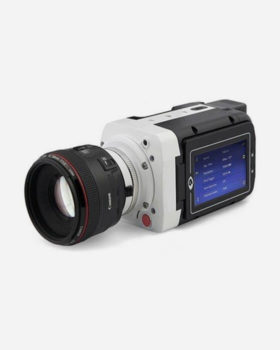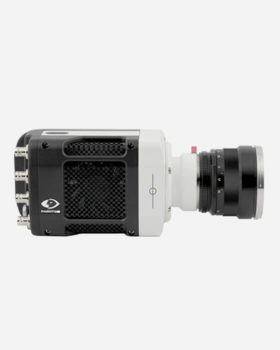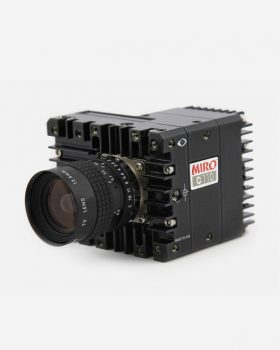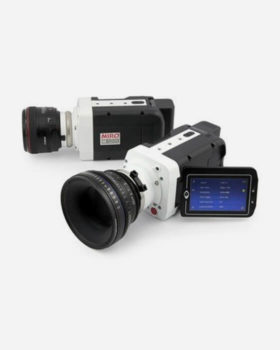| Throughput/Speed | 1.6 Gpx/s, Maximum speed at full resolution of 1280 x 800 is 1600 fps, Maximum speed at reduced resolution of 64 x 8 is 400,000 fps, Minimum frame rate of 24 fps, Shutter speeds down to 2 microseconds |
|---|
| Sensor Specifications | CMOS sensor, 1280 x 800 pixels, 20 µm pixel size, 25.6 mm x 16.0 mm, 12-bit depth, ISO Mono 6,400D; 16,000T, ISO Color 2,000D; 2,000T, TE cooled, CAR in 64 x 8 increments, Fill factor: 56%, Dynamic range: 57.7 dB, Read out noise at 34.3°C (typical): 29e-, Full well capacity (typical): 26300e- |
|---|
| Exposure | 2 µs minimum exposure, electronic shutter, Extreme Dynamic Range (EDR), Auto Exposure, Shutter Off mode for PIV applications |
|---|
| Memory | 6GB, 12GB high-speed internal RAM, CineFlash support |
|---|
| Record Times | 4.7 seconds at maximum frame rate, 12-bit depth, largest resolution and into maximum internal memory |
|---|
| Special Features | Segment memory for up to 63 cines in multi-cine mode, Image-Based Auto-Trigger, Continuous recording, Memory gate, Event marking, Frame timestamp, IRIG In (modulated or unmodulated), IRIG Out (unmodulated), Shutter off mode for PIV exposure, 500 ns straddle time, Burst mode, Standard internal mechanical shutter for automatic/remote Current Session Reference (CSR), Secondary IP address, Field-based firmware upgrade capable |
|---|
| Triggering | Programmable trigger location (pre/post trigger recording), Image-Based Auto-Trigger standard, Trigger from software, Hardware trigger BNC |
|---|
| Timing & Synchronization | 20ns timing accuracy, Frame synchronization to internal or external clock (FSYNC), IRIG In (modulated or unmodulated), IRIG Out (unmodulated) |
|---|
| Signaling | On the M, R and LC styles: Capture connector (Trigger, IRIG In, Video, IRIG Out, Aux1, Aux2), (Aux1 signal can be assigned to FSYNC, Event, Strobe or Memgate), (Aux2 signal can be assigned to Ready or Strobe), Dedicated FSYNC and Trigger connection on camera body, In software there is an Aux3 assignment that allows IRIG Out to be reassigned to Strobe, On the LAB style: I/O-1 can be assigned FSYNC, Event, Strobe or Memgate; I/O-2 can be assigned Ready or Strobe: IRIG-in and Trigger have dedicated BNCs |
|---|
| Ethernet Connection | Gb Ethernet for control and data, using standard Ethernet connection |
|---|
| Camera Control | Phantom Camera Control software (PCC), Flip-out LCD Touchscreen on LC-Series only, Remote Control Unit (RCU) (not compatible with LAB style), SDK available |
|---|
| Video Out | Analog video out (NTSC or PAL) available on Capture Cable and RCU cable, No video out on LAB style |
|---|
| Lensing | The following mounts are available:
Canon EOS, Nikon F-mount, support F & G style lenses, Nikon F mount adapter (allows the use of F-mount lenses on EOS mount), 1" C-mount, PL-mount |
|---|
| Video Processing | Brightness, Gain, Gamma, Saturation, Hue, White, Balance, Color interpolation algorithm, Flare, Pedestal, Tone curve, Filters, Color matrix, Image flip and rotate, Crop, Scale |
|---|
| Data Acquisition | Native Support in PCC, for National Instruments, X- and M-Series |
|---|
| Motion Analysis | Basic measurements via Phantom Application:
Distance, Speed, Acceleration, Angles and Angular Speed, Manual and Automatic point collection for target tracking, Compatible with 3rd party solutions |
|---|
| Supported File Formats | Cine, Cine Compressed, Cine RAW, AVI, h.264 mp4, Apple ProRes .mov, Multipage TIFF, MXF PAL, MXF NTSC, Uncompressed QuickTime, Windows BMP, OS/2 BMP, PCX, TGA, TIFF, LEAD, JPEG, JTIF, RAW, DNG, DPX |
|---|
| Power | 12 – 28 VDC, 65 W, 100 – 240 VAC power supply included, Rechargeable battery (Sony BP-U30 or BP-U60), Battery not available on LAB style |
|---|
| Mechanical Specifications | Vedi tabella in DOCUMENTAZIONE |
|---|
| Environmental Specifications | Vedi tabella in DOCUMENTAZIONE |
|---|
| APIs | Phantom SDK, LabView, MatLab |
|---|
| Ships Standard With | Power supply, Ethernet cable, Battery; Sony BP-U30 or BP-U60 rechargeable, external charger required (No battery with LAB style), Phantom PCC software, 120GB CineFlash and Dock (not bundled with LAB style), Mini Break-out-Box (not required with LAB style) |
|---|
| Options | Upgrade bundled 120GB CineFlash to 240GB, While CineFlash is available for the LAB style camera, there is no bundled CineFlash or Dock |
|---|
| Popular Accessories | Remote Control Unit (M, R only), Spare batteries, battery charger (M, R, LC only), Additional CineFlash modules |
|---|






